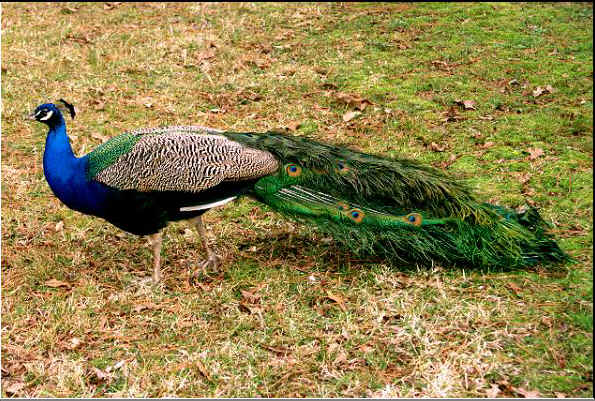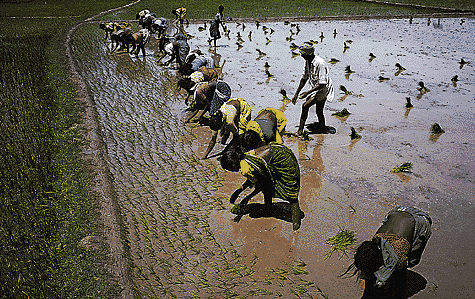

NEWS
Headlines

E-mail
with INDIA- a site by Abhishek Sood! |

| |
Animals and Plants

- India's national bird - the Peacock
Because of its size, India is home to a wide range of different environments, from high, snow-capped mountains to tropical rainforests and from hot and cold deserts and scrubland to lush, fertile plains and valleys. These environments provide a great variety of habitats for India's rich animal and plant life.

- India's national animal- the Tiger
Animals. Many zoologists estimate that there are some 76,000 species of fauna (animals) in India. They include (1) mammals, (2) birds, (3) reptiles and amphibians, (4) fish, and (5) insects and other invertebrates (animals without backbones).
Mammals. Among the best-known of India's mammals are the Indian elephant and the tiger. The Indian elephant is found all over India except in Kashmir, Punjab, and the western desert. Domesticated elephants in India today are important in the timber industry.
Tigers are India's largest cats. They live in the country's forests and grassy plains and swamps, especially the wooded foothills of the Himalaya. Other cats of India include four species of panther--the common leopard; the all-black leopard; the rarely seen albino leopard; and the snow leopard, which is found only in the Himalaya. The Asiatic lion is now found only in the Gir Forest of Saurashtra, Gujarat.
The one-horned rhinoceros is a protected species confined to eight wildlife sanctuaries, the largest of which is the Kaziranga in Assam, home to 400 rhinoceros. The commonest species of monkeys found in India are the rhesus monkey and the Hanuman monkey, a type of langur. Another type of monkey, the lion-tailed macaque or wanderoo, is found in a small area of southern India.
The gaur or Indian bison is a species of wild buffalo. The nilgai, or blue bull, is found in most areas of the country. The markhor and Asiatic ibex, two types of goat, live in the Himalaya. India also has various kinds of wild antelope, bear, deer, gazelle, goat, pig, and sheep. The Karakul is a wild sheep of northwestern India.
Domesticated animals include cattle, sheep, goats, water buffalo, camels, donkeys, mules, horses, and, in the Himalaya, yaks.
The Ganges dolphin (Platanista gangetica) is a fresh-water dolphin that lives in the Ganges, Brahmaputra, and Indus rivers. It may be up to 3.6 metres in length.
Birds. About 1,200 species of birds live in India. More than 85 per cent of India's bird types are resident within the country. The rest are migratory. Migrating birds reach India in September to November and fly back during March and April.
Common birds of India include birds of prey such as the falcon, hawk, and osprey; vultures; ducks, geese, swans, cormorants, frigate birds, flamingos, herons, kingfishers, and other water birds; and parrots and songbirds of various kinds. Game birds include the snipe, pheasant, and grey or black partridge; the sand grouse of Rajasthan; and the green pigeon, quail, and Indian bustard, which is an endangered species. The myna bird, a relative of the starling, is one of nature's greatest mimics. Jungle fowl inhabit India's forests. The Indian peacock is India's national bird.
Reptiles and amphibians. India has more than 400 species of reptile. The gavial, or gharial, a long-snouted animal related to the crocodile, lives in the waters of the Ganges, Brahmaputra, Indus, and Mahanadi. The gavial can reach a length of 6.5 metres. The crocodile itself exists in three species in India. One, the estuarine crocodile (Crocodilus porosus), is said to reach nearly 10 metres. Among turtles, tortoises, and terrapins, about 50 species are known. The largest is the leathery turtle.
India has some 400 species of snakes, of which about 80 species are poisonous. These deadly snakes include 25 species of sea snakes, 11 species of krait, and the cobra and king cobra. The wolf snake, rat snake, and grass snake are harmless.
India has three common species of frog--the bullfrog, the water-skipping frog, and the burrowing frog. There are also two groups of tree frogs.
Fish. True salmon and trout are not native to Indian rivers but have been introduced successfully. There are also catfish, various members of the carp family, the hilsa (a type of herring), the pomfret, and the Bombay duck (a food fish of northern India).
Insects and other invertebrates. Mosquitos are plentiful and spread diseases such as malaria. Locusts occasionally devastate crops causing economic disaster in some areas. But some insects are useful to humans. They include the silkworm and the honey bee. The insect Coceus laca produces a resinous liquid called lac, from which shellac is made. India also has many species of beautiful butterflies.
India has 90 species of scorpions, 250 species of spiders, and about 1,000 species of crabs, prawns, and lobsters. Among molluscs, the Indian pearl oyster is economically important. An African snail known as Achatina has damaged crops in parts of western India.

- India's national flower - the Lotus
Plants. Almost every plant family in the world is represented in India's richly varied flora (plant life). But certain kinds of plants are distinctive features of India's differing regions and climates.
In northern India, the valleys of the eastern Himalaya are home to a wide variety of broadleaved trees, such as alder, birch, laurel, and maple, and conifers such as juniper. The area is also known for its rhododendrons, bamboo, and dwarf willow. Juniper, silver birch, and silver fir are abundant in the uppermost, alpine environment of the western Himalaya. Further down the mountain slopes grow forests of spruce, silver fir, and deodar (East Indian cedar). Sal forests dominate the lowest regions, providing a wood much used in the furniture industry. Forests of sal are also found in the region of the Ganges. Tall grasses and forests of bamboo grow in the Brahmaputra and Surma valleys of Assam. Assam is also one of the original homes of the mango, a commercially important fruit of south and east Asia. In the valleys of the Himalaya, farmers grow apple, apricot, peach, pear, and walnut trees.
In southern India, the dry environment of the Deccan plateau provides good growing conditions for various kinds of palm. Tropical plants grow in western India. Commercial crops of the region include bananas, betel nuts, cardamon, citrus fruit, coconuts, coffee and tea, ginger, pepper, and rubber. Ironwood, rosewood, and teak are plentiful in the broadleaf forests of the region. Much rarer is the group of tree species supplying India's sandalwood.
In many regions of India, farmers grow rice, peas, beans, and lentils. The bark of the cinchona tree contains quinine, a substance used to combat malaria.

- Rice Farmers
Conservation of animals and plants is important in India. There are 19 national parks and 202 sanctuaries throughout the country.
Among India's wildlife, experts believe that about 66 species of mammals, 38 species of birds, 18 species of amphibians, all 3 species of India's crocodiles, and 135 species of plants are in danger. India is a member of CITES, the Convention on International Trade in Endangered Species of Wild Flora and Fauna. The nation's major conservation projects include a crocodile breeding and management programme organized by the Food and Agriculture Organization and a Tiger Project.
 (Back to top)
(Back to top)
|

